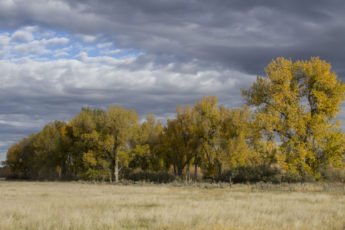Years ago, Montana set the stage for keeping her people on the land
Few topics draw battle lines faster than access for hunting and fishing in Montana. Bar fights start, dogs snarl, off in the distance you hear a hawk cry as the noon sun beats down on hunters and landowners facing off in the middle of the street, nervously fingering their phones in case they need to call their lawyers. Shopkeepers close up stores, quickly throwing up the storm shutters as if a little bit of pine would stop the world from entering and spoiling the sarsaparilla.
Maybe not. But the tension is real and it frequently seems to boil over, causing headlines and headaches. Few success stories get told about the ways we connect hunters with private landowners in Montana. Which is a shame because there are quite a few success stories out there.
Montana has, for over 30 years, invested wisely in better management of wildlife for landowners and increased access for hunters and anglers. We created the Block Management System in the late 1980s, which helps landowners manage hunting on their property, while providing access to over 7 million acres of private land and opening up some of the 1.5 million acres of public land otherwise landlocked and off-limits for recreation. This wildly popular program is funded through sportsman license fees.
In 1988, we developed Habitat Montana, which has conserved over 240,000 acres of private land and helped purchase more than 15,000 acres of now-public land, dedicated to wildlife conservation. Habitat Montana is the centerpiece of Montana’s conservation ethos. Using this program, We’ve conserved some of our best winter habitat for elk and mule deer, ensured plentiful space for critters and reduced crop damage for farmers and ranchers. We’ve made access a critical part of our state’s conservation legacy. And while it’s been controversial at times, Habitat Montana has helped put and keep Montanans in the field, chasing deer, elk, pronghorn, and more.
Three recent opportunities highlight what the Habitat Montana means for access, and what it means for Montanans.
1.) Three large-scale conservation easements were recently approved by the state Fish and Wildlife Commission. Access through these 39,000 acres on three different ranches across eastern Montana will also open up hundreds of thousands of acres of landlocked public land, ensuring that future generations of ranchers can continue to work the land and provide stewardship for our wildlife. These easements will also benefit local businesses in surrounding communities like Hysham, Wibaux and Miles City as more hunters flock to these areas now that they have more options for access, filling restaurants, hotels and stores.
2.) One parcel of 425 acres of prime river bottom was purchased with a variety of funds, including Habitat Montana. This strategic purchase adds to an existing Wildlife Management Area and means better hunting opportunities around the Bighorn River. These 425 acres may not sound like much, but it’s the quality of the acreage that makes the project worthwhile. Ducks, pheasants, whitetail deer all value this area, and ground this fertile along the Bighorn is already at a premium. With more and more people saying they’ve had to give up hunting or fishing because they’ve lost access to traditional spots, 425 acres can go a long way to nurturing new hunters and anglers and feeding the sustainable businesses that support those who come to throw flies at big rainbows, or throw lead at pheasants.
3.) We also missed some opportunities: There is a little spot north of Helena, next to the Canyon Creek Wildlife Management Area, that acts as an elk magnet during the hunting season. It’s a postage-stamp-sized ranch that has been off-limits to hunting for a variety of reasons (although it had recently been allowing youth hunting to help disperse the elk and reduce the herd down to a reasonable size). That ranch recently went up for sale, with the landowner approaching Montana Fish, Wildlife and Parks about purchasing it. Due to a legislative hissy-fit in 2015, FWP was not allowed to spend its own money on increasing access, which would have helped surrounding landowners deal with problematic wildlife issues and better manage both wildlife and wildlife habitat.
Access is always one of the biggest issues facing hunting and fishing. Landowners feel like they’re being forced into allowing people to trespass, and hunters feel like they’re getting squeezed out. Programs like Habitat Montana bring landowners, sportsmen and our wildlife managers together to find that middle-ground where we can all be happy.
Montanans meet on the Sun River Game Range (est 1948) to discuss management for increased carrying capacity for elk, while reducing damage to private land. Habitat Montana helps ensure that these Wildlife Management Areas work for neighboring landowners as well as sportsmen through good neighbor policies, noxious weed management and proper fencing.
There will always be a controversy on some specific area like the current access issues in the Crazy Mountains. That conflict is used on both sides to whip emotions and push agendas, which is human nature, however sad.
With 1.5 million acres of state and federal public land off-limits to Montanans, the only way we solve that issue and get people to work together is to ensure that program like Habitat Montana remain intact and functioning as intended. Thankfully, and due to the hard work of legislators like Republican Senator Jeff Welborn of Dillon and Democratic Representative Jim Keane of Butte, Habitat Montana made it through the Legislature intact, with $13 million to spend on conservation easements and new Wildlife Management Areas. All of Montana will once again able to use one of our greatest tools to increase access and protect family farms and ranches.

